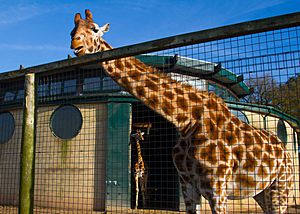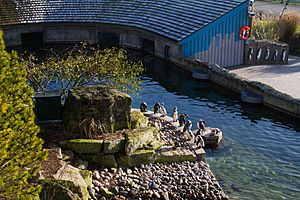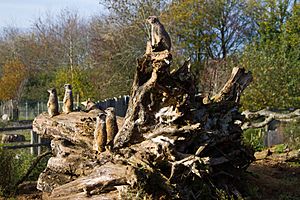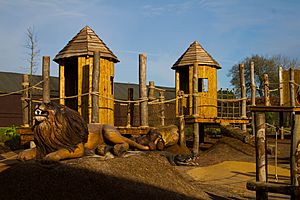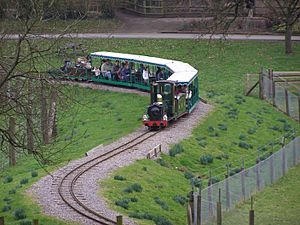Marwell Zoo facts for kids
 |
|
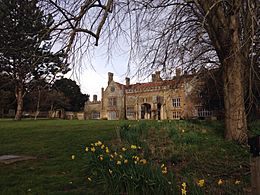
Marwell Hall, March 2016
|
|
| Date opened | 1972 |
|---|---|
| Location | Owslebury, Hampshire, England, United Kingdom |
| Land area | 140 acres (57 ha) |
| Coordinates | 50°59′35.39″N 1°16′39.85″W / 50.9931639°N 1.2777361°W |
| No. of animals | 1208+ (2019) |
| No. of species | 149 (2019) |
| Annual visitors | 511,000 (2006) |
| Memberships | BIAZA, EAZA, WAZA, IUCN |
| Major exhibits | Roof of the World, Into Africa, Heart of Africa, Life in the Trees, Wild Explorers, African Valley, Fur-Feathers-Scales, Energy For Life: Tropical House, Aridlands |
| Website | http://www.marwell.org.uk |
Marwell Zoo is a large zoo covering 140 acres (57 ha) in Colden Common, near Winchester in England. It is run by a special group called Marwell Wildlife, which is a charity. The zoo is home to over 1,200 animals from 149 different species.
Marwell Wildlife does a lot of work to help animals and teach people about them. They focus especially on animals in Africa, but also do important work right from their home base.
Contents
Discovering Marwell Zoo's Past
The zoo was started by Dr. John Knowles in 1972. He even sold his fancy car to buy some zebras! Marwell Zoo was one of the first zoos in Europe to really focus on saving animals.
Soon after it opened, the zoo became very good at breeding rare animals. Some of these animals, like the Mongolian wild horse, had already disappeared from the wild. Others, like the snow leopard and Siberian tiger, were close to disappearing.
The zoo is located on the land of Marwell Hall. This old building was first built around 1320. A local story says that King Henry VIII married Jane Seymour there many years ago.
In 1977, a giraffe named Victor became famous. He hurt his leg and couldn't stand up. Many people around the world heard about him. Even the Portsmouth Dockyard tried to help by making a special lift. Sadly, Victor passed away, but his story made Marwell a very popular place to visit. The next year, Victor's mate, Dribbles, had a baby girl named Victoria.
In 1991, Dr. John Knowles received a special award for all his work in saving animals.
In 1999, the zoo lost all its penguins to a bird sickness called avian malaria. After getting advice from experts, they brought in Humboldt penguins. These penguins are still endangered in the wild, but there are more of them in zoos.
In 2003, a female Amur leopard named Jade escaped from her new home. Sadly, she died after being given a tranquilizer. Later, in 2005, a new baby leopard named Amirah was accidentally killed by her father. But in 2007, another Amur leopard cub, Kiska, was born as part of a special program to help save these rare animals.
In 2009, the zoo and charity changed their names to "Marwell Wildlife." This was to show that they do important conservation work all over the world, not just at the zoo.
Amazing Animal Homes
Marwell Zoo has many different areas where animals live. Each area is designed to feel like the animals' natural homes.
- Roof of the World is like the Himalayas mountains. Here you can see snow leopards and a Northern white-faced owl.
- World of Lemurs has a glass walkway where you can see different types of lemurs, like black and white ruffed lemurs and ring tailed lemurs. You can also spot small monkeys like Guianan Squirrel Monkeys and Golden Lion Tamarins.
- Lemur Loop is a special area that opened in 2017. You can walk right through it and get close to three different lemur species. It's a fun way to see these playful animals!
- Penguin Cove was updated in 2012 and is home to 15 Humboldt penguins.
- Aridlands & Desert Carnivores is where you'll find animals that live in dry places, like addax and dorcas gazelles.
- Fur, Feathers & Scales has a walk-through area for African birds. It also has the Cold Blooded Corner with rare reptiles like the Gila monster and Madagascan tree boa. In 2019, a new home was built for the red pandas.
- Australian Bush Walk has two walk-through parts. In one, you can see Bennett's wallabies. The other is a bird area.
- Life in the Trees looks like an Indonesian rainforest. It features siamangs, anoa, and Asian small-clawed otters.
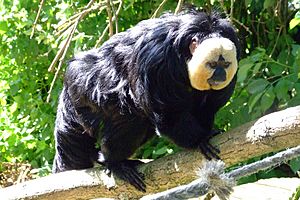
- The Valley Field is a big area where Hartmann's Mountain Zebras roam around a waterhole.
- Wild Explorers opened in 2015. This exhibit teaches you about southern white rhinos, Common Ostriches, Grevy's zebras, and scimitar-horned oryx.
- Formal Garden opened in 2010. It has beautiful gardens and a special 'tree trail' where you can learn about different trees. You can also see Cotton-topped Tamarins and Blue-crowned Laughing Thrushes here.
- Energy For Life: Tropical House opened in 2018. This amazing building has two levels. You can see a Linne's two-toed sloth, birds flying freely, tropical fish, an iguana, and even mouse deer! It's a great place to learn how energy moves through living things.
Meet the Animals
Marwell Zoo is home to a wide variety of animals!
- Over 200 mammals from 59 species, including tamarins, meerkats, leopards, Amur tigers, and Sudan cheetahs.
- Over 180 birds from 37 species, like rheas, ibis, and flamingoes.
- More than 50 reptiles from 17 species, including tortoises.
- Over 10 amphibians from 3 species, such as poison dart frogs.
- More than 25 fish from 19 species.
- Over 700 invertebrates from 14 species, including leaf cutter ants.
Marwell Zoo is especially known for its large collection of hoofed animals, called ungulates. These include:
- Scimitar-horned oryx
- Arabian oryx
- Addax
- Roan antelope
- Sable antelope
- Lesser kudu
- Nyala
- Dorcas gazelle
- Sitatunga
- Eastern bongo
- African forest buffalo
- Lowland anoa
- Grevy's zebra
- Hartmann's mountain zebra
- Przewalski's horse
- Somali wild ass
- Southern white rhino
- Lowland tapir
- Rothschild giraffe
- Okapi
- Collared peccary
- Warthog
- Pygmy hippopotamus
Helping Animals: Conservation Efforts
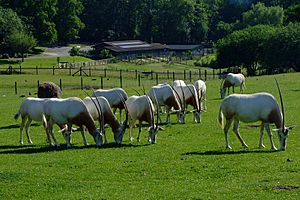
Marwell Wildlife works hard to protect animals around the world. Their main projects include:
- Helping to protect nature in Hampshire, England.
- Supporting Grevy's zebras and their homes in Kenya.
- Helping endangered species in Zimbabwe.
- Bringing back the scimitar-horned oryx to the Sahara desert.
The zoo has helped bring back animals like the wild horse, golden lion tamarin, roan antelope, and scimitar oryx to the wild. The scimitar oryx was once completely gone from the wild. But since 1972, over 200 calves have been born at Marwell Zoo. Many of these have been released back into the Sahara!
Marwell Wildlife also does a lot of research and teaches people about conservation. They even have an office for a group that specializes in antelopes.
Marwell Zoo has been very successful at breeding endangered animals. These include the critically endangered black and white ruffed lemur and Amur leopard, and the snow leopard. In 2015, a baby Sulawesi-crested macaque was born, which is also critically endangered.
In October 2018, a baby Hartmann's Mountain Zebra was born at the zoo. This was very important because the mother, Dorotka, has special genes that are needed for the zebra population in Europe. The last time this vulnerable species successfully bred at the zoo was in 1997.
Fun Things to Do at the Zoo
Besides seeing the animals, Marwell Zoo has lots of other fun things for families!
There are five children's playgrounds, places to buy food, and two indoor picnic areas. You can also have a picnic on the Marwell Hall lawn. There's even a hotel next to the park if you want to stay longer.
The Marwell Wildlife Railway is a small train that takes you around the front part of the zoo. It's often called the Marwell Zoo Railway. The train track is almost a kilometer long and has two stations: Treetops Junction and Park End Halt. The railway opened in 1987 and still uses its original trains. It runs every day during school holidays and on weekends during spring, summer, and autumn. It's usually closed in winter.
The train is pulled by a steam-style locomotive named Princess Anne. There are four passenger coaches, and each can hold 16 people. The coaches have roofs but are open on the sides.


